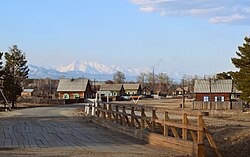Kurumkansky District
Курумканский район | |
|---|---|
| Other transcription(s) | |
| • Buryat | Хурамхаанай аймаг |
 Village (selo) Baraghan, Kurumkansky District | |
 Location of Kurumkansky District in the Buryat Republic | |
| Coordinates: 54°19′N 110°19′E / 54.317°N 110.317°E | |
| Country | Russia |
| Federal subject | Republic of Buryatia[1] |
| Established | December 11, 1970[2] |
| Administrative center | Kurumkan[1] |
| Area | |
| • Total | 12,450 km2 (4,810 sq mi) |
| Population | |
| • Total | 15,007 |
| • Density | 1.2/km2 (3.1/sq mi) |
| • Urban | 0% |
| Administrative structure | |
| • Administrative divisions | 5 Selsoviets, 4 Somons |
| • Inhabited localities[1] | 28 rural localities |
| Municipal structure | |
| • Municipally incorporated as | Kurumkansky Municipal District[5] |
| • Municipal divisions[5] | 0 urban settlements, 10 rural settlements |
| Time zone | UTC+8 (MSK+5 |
| OKTMO ID | 81630000 |
| Website | http://kurumkan.burnet.ru |
| 2010 Census | 15,007[4] |
|---|---|
| 2002 Census | 16,235[7] |
| 1989 Census | 18,852[8] |
| 1979 Census | 17,928[9] |
Kurumkansky District (Russian: Курумка́нский райо́н; Buryat: Хурамхаанай аймаг, Khuramkhaanai aimag) is an administrative[1] and municipal[5] district (raion), one of the twenty-one in the Republic of Buryatia, Russia. It is located in the northeast of the republic. The area of the district is 12,450 square kilometers (4,810 sq mi).[3] Its administrative center is the rural locality (a selo) of Kurumkan.[1] As of the 2010 Census, the total population of the district was 15,007, with the population of Kurumkan accounting for 36.4% of that number.[4]
- ^ a b c d e Resolution #431
- ^ Cite error: The named reference
OffHistwas invoked but never defined (see the help page). - ^ a b Official website of the Buryat Republic. Information about Kurumkansky District Archived May 28, 2012, at the Wayback Machine (in Russian)
- ^ a b c Russian Federal State Statistics Service (2011). Всероссийская перепись населения 2010 года. Том 1 [2010 All-Russian Population Census, vol. 1]. Всероссийская перепись населения 2010 года [2010 All-Russia Population Census] (in Russian). Federal State Statistics Service.
- ^ a b c Law #985-III
- ^ "Об исчислении времени". Официальный интернет-портал правовой информации (in Russian). June 3, 2011. Retrieved January 19, 2019.
- ^ Federal State Statistics Service (May 21, 2004). Численность населения России, субъектов Российской Федерации в составе федеральных округов, районов, городских поселений, сельских населённых пунктов – районных центров и сельских населённых пунктов с населением 3 тысячи и более человек [Population of Russia, Its Federal Districts, Federal Subjects, Districts, Urban Localities, Rural Localities—Administrative Centers, and Rural Localities with Population of Over 3,000] (XLS). Всероссийская перепись населения 2002 года [All-Russia Population Census of 2002] (in Russian).
- ^ Всесоюзная перепись населения 1989 г. Численность наличного населения союзных и автономных республик, автономных областей и округов, краёв, областей, районов, городских поселений и сёл-райцентров [All Union Population Census of 1989: Present Population of Union and Autonomous Republics, Autonomous Oblasts and Okrugs, Krais, Oblasts, Districts, Urban Settlements, and Villages Serving as District Administrative Centers]. Всесоюзная перепись населения 1989 года [All-Union Population Census of 1989] (in Russian). Институт демографии Национального исследовательского университета: Высшая школа экономики [Institute of Demography at the National Research University: Higher School of Economics]. 1989 – via Demoscope Weekly.
- ^ Всесоюзная перепись населения 1979 г. Национальный состав населения по регионам России [All Union Population Census of 1979. Ethnic composition of the population by regions of Russia] (XLS). Всесоюзная перепись населения 1979 года [All-Union Population Census of 1979] (in Russian). 1979 – via Demoscope Weekly (website of the Institute of Demographics of the State University—Higher School of Economics.
